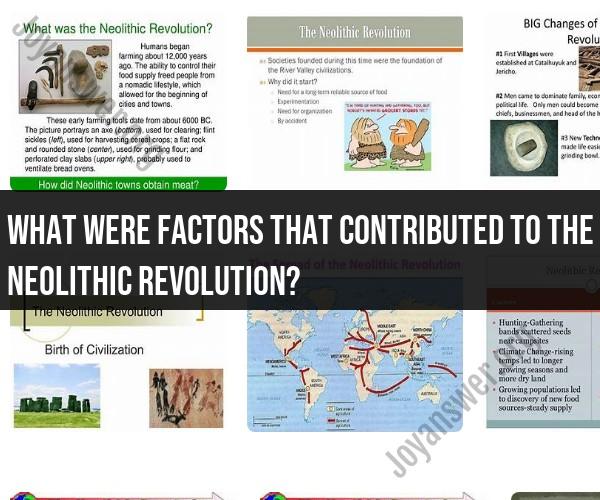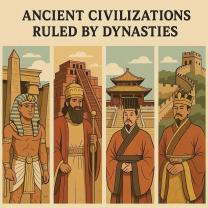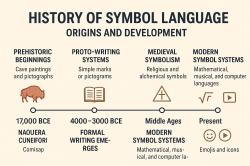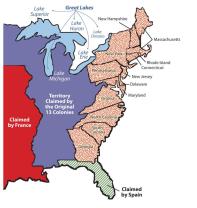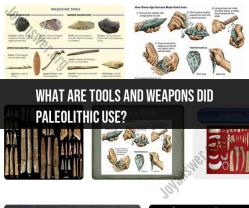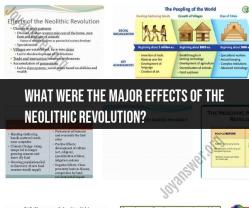What were factors that contributed to the Neolithic Revolution?
The Neolithic Revolution was a significant turning point in human history, marked by the transition from a nomadic, hunter-gatherer lifestyle to settled agriculture and the development of more complex societies. Several factors contributed to the emergence of the Neolithic Revolution:
Climate Change: Changes in climate and the end of the last Ice Age (around 10,000 BCE) led to shifts in vegetation and animal populations. As glaciers retreated, new plant and animal species became more accessible, making certain areas suitable for agriculture.
Domestication of Plants: Early humans began to experiment with and cultivate wild grasses such as wheat, barley, rice, and maize. This led to the development of agriculture, as they learned to select and propagate the most desirable traits in plants.
Domestication of Animals: Humans started to tame and breed animals for various purposes, including food (e.g., cattle, sheep, goats), labor (e.g., horses, oxen), and transportation. This allowed for a more stable and reliable source of food.
Sedentism: As people settled down to cultivate crops and raise animals, they became more sedentary. This led to the establishment of permanent villages and towns.
Population Growth: With a more stable food supply, populations began to grow. This necessitated better organization and more efficient food production, leading to more complex social structures.
Food Surpluses: Agriculture enabled the production of food surpluses. These surpluses could be stored for future use or traded, freeing up some individuals to specialize in other activities like pottery, toolmaking, or governing.
Technological Advancements: The need for efficient farming tools and practices led to technological innovations such as the plow, irrigation systems, and crop rotation. These innovations improved agricultural productivity.
Social and Economic Changes: As societies grew more complex, they developed systems of trade, commerce, and economic exchange. Specialization of labor allowed for the development of various professions and trades.
Settlement and Urbanization: As communities grew in size and complexity, some evolved into early cities. Urban centers became hubs of trade, governance, and cultural exchange.
Social Hierarchies: With the rise of agriculture and surplus resources, social hierarchies developed. Some individuals or groups held positions of power, and the concept of private property emerged.
Technological and Cultural Developments: The Neolithic Revolution led to various cultural and technological advances, including the development of written language, pottery, metallurgy, and the construction of more permanent and elaborate structures.
Environmental Impact: Agriculture and the growth of human populations had an impact on the environment, including deforestation and changes in ecosystems. These changes influenced human settlement patterns and practices.
The Neolithic Revolution was a fundamental transformation that laid the foundation for more complex and organized societies. It marked the beginning of agriculture, which, in turn, led to the development of civilizations, the growth of cities, and the emergence of many aspects of modern human life, such as trade, government, and written language.
Factors Contributing to the Neolithic Revolution: A Historical Perspective
The Neolithic Revolution was a major turning point in human history, marking the transition from hunter-gatherer societies to agricultural societies. It began around 10,000 years ago in the Fertile Crescent region of the Middle East and spread to other parts of the world over the next few thousand years.
There are a number of factors that contributed to the Neolithic Revolution, including:
- Climate change: The end of the last Ice Age led to a warmer and more stable climate, which made it possible for plants and animals to thrive.
- Population growth: The human population was growing during this time, which put a strain on existing food resources.
- Technological advancements: Humans developed new technologies, such as the plow and the sickle, which made it easier to farm.
- Social organization: Hunter-gatherer societies were typically small and egalitarian, but agricultural societies required more complex social organization to coordinate and manage food production.
Analyzing the Catalysts and Drivers of Neolithic Change
The catalysts and drivers of Neolithic change are complex and multifaceted. Some of the most important factors include:
- Environmental factors: The end of the last Ice Age led to a warmer and more stable climate, which made it possible for a wider range of plants and animals to thrive. This created new opportunities for humans to cultivate crops and domesticate animals.
- Economic factors: The growing human population put a strain on existing food resources. Agriculture allowed humans to produce more food in a smaller area, which supported larger populations and led to the development of more complex societies.
- Technological factors: Humans developed new technologies, such as the plow and the sickle, which made it easier to farm. These technologies also allowed humans to clear forests and plant crops on new land.
- Social factors: Hunter-gatherer societies were typically small and egalitarian, but agricultural societies required more complex social organization to coordinate and manage food production. This led to the development of new social structures, such as hierarchies and social classes.
Societal Shifts and Their Role in the Neolithic Transformation
The Neolithic Revolution brought about a number of societal shifts. One of the most significant shifts was the transition from hunter-gatherer societies to agricultural societies. This shift had a profound impact on human culture and society.
Hunter-gatherer societies were typically nomadic, meaning that they moved from place to place in search of food. Agricultural societies, on the other hand, were sedentary, meaning that they settled in one place and cultivated crops. This shift to a sedentary lifestyle led to the development of new social structures, such as villages, towns, and cities.
The Neolithic Revolution also led to the development of new technologies and tools. For example, humans developed the plow to cultivate crops, the sickle to harvest crops, and the pottery wheel to make pottery. These technologies made it possible to produce more food and to store it for longer periods of time.
The Neolithic Revolution's Impact on Human Development
The Neolithic Revolution had a profound impact on human development. It led to the development of agriculture, which supported larger populations and more complex societies. It also led to the development of new technologies and tools, which made it possible to produce more food and to store it for longer periods of time.
The Neolithic Revolution also had a significant impact on human culture. For example, humans developed new forms of art and architecture during this time. They also developed new religious beliefs and practices.
Insights from Experts and Enthusiasts on Neolithic Revolution Factors
Experts and enthusiasts on the Neolithic Revolution have a variety of insights on the factors that contributed to this major transformation in human history.
Some experts believe that the Neolithic Revolution was caused by environmental factors, such as the end of the last Ice Age and the resulting climate change. Others believe that the Neolithic Revolution was caused by economic factors, such as the growing human population and the need for more food. Still others believe that the Neolithic Revolution was caused by a combination of factors, including environmental, economic, technological, and social factors.
Enthusiasts of the Neolithic Revolution often focus on the positive aspects of this transformation, such as the development of agriculture and the resulting increase in food production. However, some experts have cautioned that the Neolithic Revolution also had negative consequences, such as the rise of social inequality and the destruction of the environment.
Overall, the Neolithic Revolution was a complex and multifaceted event that had a profound impact on human development. There is no single factor that can be credited with causing the Neolithic Revolution. Rather, it was a combination of factors that led to this major turning point in human history.
